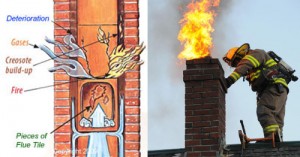Your chimney and fireplace may serve as a centerpiece of your home, but if left uncleaned and unattended, it can quickly turn to ash and dust. While you are comfortable in front of that fire, the last thing you are probably thinking of is having your chimney cleaned or inspected, but hefty creosote, smoke, and debris buildup can cause a rude awakening in the blink of an eye.
For those who do experience a chimney fire, the price could be costly or even deadly. How chimney fires damage and affect chimneys often comes down to the type of chimney and the amount of build-up due to the lack of care.
 Masonry Chimneys
Masonry Chimneys
According to the CSIA, masonry chimneys old or new can come unlined, tile-lined, and otherwise, and at the high temperatures chimney fires burn, these masonry chimneys can begin to melt mortar, crack tiles, cause liners to collapse, and even damage the outer masonry work. Usually, thermal shock happens during a chimney fire in a masonry chimney and tiles crack and mortar is displaced, creating a pathway for flames to reach the combustible wood frame of the home, which makes for a very dangerous situation and more significant danger and damage.
Pre-Fabricated, Factory-Built, Metal Chimneys
Usually, these pre-fabricated, factory-built metal chimneys are made to vent wood burning stoves or other pre-fabricated metal fireplaces. For that reason, these must pass certain tests requiring the chimney to withstand flue temperatures up to 2100° Fahrenheit, without sustaining damage, in order to even be installed in most places. However, sometimes damage can still occur, often times in the form of buckled or warped seams and joints on the inner liner. If that is the case, these types of chimney should no longer be used and should be replaced immediately.
Special Effects on Wood Stoves
Obviously, wood stoves are made to contain hot fires, but the pipes that connect the stove to the chimney are a different story and cannot withstand high temperatures. For that reason, fire can warp, buckle, and sometimes separate from the vibrations caused by the turbulence in the air during a fire. These pipes will need to be replaced if they are damaged by a chimney fire.
As stated, not all chimneys receive visible damage and luckily some people can come away unscathed and not even know that they have experienced a chimney fire at all. It is a good idea to have your chimney inspected regularly, usually around late summer or early fall before you heat up for the winter.
Here are ways a professional chimney sweep can tell you’ve had a chimney fire:
- Warped metal.
- “Puffy” creosote.
- Cracks in the exterior of the masonry.
- Roof damage.
- Creosote flakes found on the roof or ground.
- Evidence that smoke has escaped through mortar joints of masonry or tile liners.
- Cracked or collapsed flue tiles, or tiles having pieces missing.
- Discolored or misshapen and distorted rain cap.
- TV antenna or dish attached to chimney has heat or smoke damage
- If you think you have had a chimney fire, do not hesitate to contact a chimney sweep professional for further assistance and assurance. Pending the situation, your chimney or chimney accessories will probably need to be updated, replaced, or brought back into compliance with safety standards.
Resources: Weather.com, Chimney Safety Institute of America
